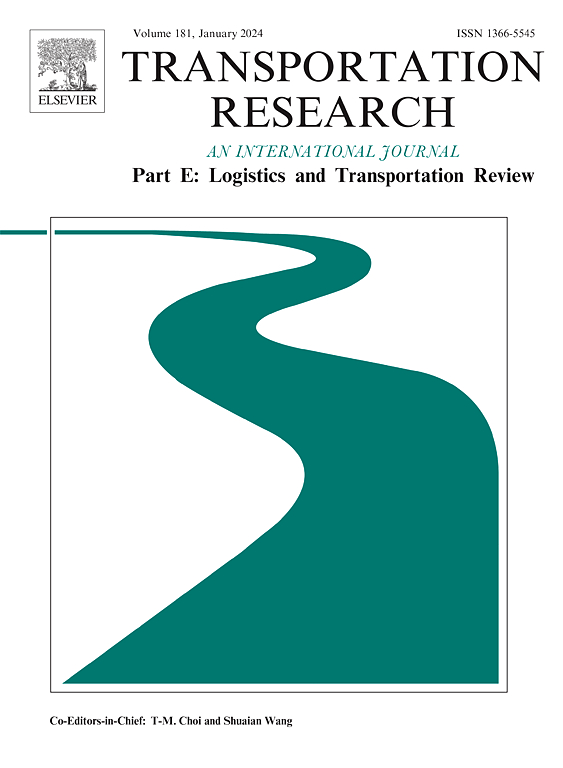On the optimal micro-hub locations in a multi-modal last-mile delivery system
IF 8.8
1区 工程技术
Q1 ECONOMICS
Transportation Research Part E-Logistics and Transportation Review
Pub Date : 2025-08-05
DOI:10.1016/j.tre.2025.104344
引用次数: 0
Abstract
Last-mile delivery is one of the most polluting parts of the supply chain. This is partially caused by increased congestion in urban areas and repetitive stop-and-go traffic. One possible alternative to this is to use micro-mobility to replace large motorized vehicles. However, these vehicles are usually slower and have lower capacity. In this work, we propose a multi-modal logistics system for last-mile delivery that combines the use of trucks, metro and micro-mobility. This innovative type of system uses the metro to distribute the parcels to micro-hubs across the network and uses micro-mobility only for the final part of the parcel’s itinerary from the micro-hub to the front door of the customer. We focus on finding the optimal micro-hub locations in such a system. We use a continuum approximation of the operational and tactical decisions which includes routing of the micro-mobility vehicles. The whole problem is then modeled as a Mixed Integer Linear Programming (MILP) model for the strategic decisions regarding the micro-hubs, which include location, capacity, and fleet-assignment decisions. We evaluate the results of a case study of the city of Madrid, which illustrates that a multi-modal last-mile delivery system can significantly improve a traditional last-mile delivery system in terms of operational costs and pollution.
多式联运最后一英里配送系统中微枢纽的最佳位置
最后一英里的配送是供应链中污染最严重的环节之一。这在一定程度上是由城市地区日益拥堵和反复走走停停的交通造成的。一种可能的替代方案是使用微型机动性来取代大型机动车辆。然而,这些车辆通常速度较慢,容量较低。在这项工作中,我们提出了一种结合卡车、地铁和微移动的最后一英里交付的多式联运物流系统。这种创新的系统使用地铁将包裹分发到网络中的微型枢纽,并且只在包裹从微型枢纽到客户前门的行程的最后一部分使用微型移动性。我们的重点是在这样一个系统中找到最佳的微中心位置。我们使用了包括微机动车辆路线在内的作战和战术决策的连续近似。然后将整个问题建模为关于微枢纽的战略决策的混合整数线性规划(MILP)模型,其中包括位置、容量和车队分配决策。我们评估了马德里市的一个案例研究结果,该研究表明,多式联运的最后一英里配送系统可以在运营成本和污染方面显著改善传统的最后一英里配送系统。
本文章由计算机程序翻译,如有差异,请以英文原文为准。
求助全文
约1分钟内获得全文
求助全文
来源期刊
CiteScore
16.20
自引率
16.00%
发文量
285
审稿时长
62 days
期刊介绍:
Transportation Research Part E: Logistics and Transportation Review is a reputable journal that publishes high-quality articles covering a wide range of topics in the field of logistics and transportation research. The journal welcomes submissions on various subjects, including transport economics, transport infrastructure and investment appraisal, evaluation of public policies related to transportation, empirical and analytical studies of logistics management practices and performance, logistics and operations models, and logistics and supply chain management.
Part E aims to provide informative and well-researched articles that contribute to the understanding and advancement of the field. The content of the journal is complementary to other prestigious journals in transportation research, such as Transportation Research Part A: Policy and Practice, Part B: Methodological, Part C: Emerging Technologies, Part D: Transport and Environment, and Part F: Traffic Psychology and Behaviour. Together, these journals form a comprehensive and cohesive reference for current research in transportation science.

 求助内容:
求助内容: 应助结果提醒方式:
应助结果提醒方式:


